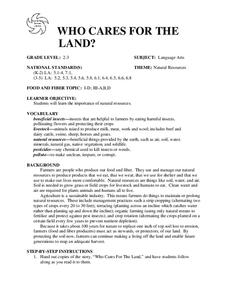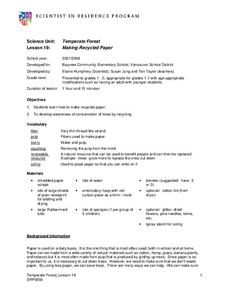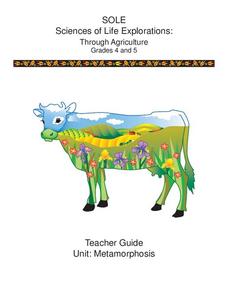Cornell University
Fibers, Dyes, and the Environment
Nanofibers can be made through electrospinning or force spinning in order to reduce the negative impact on the environment. Pupils study the role of fibers and dye on the environment through a series of five hands-on activities. Then,...
Curated OER
Bird Brilliance!
First graders explore natural resources and search outdoors to find materials to create a bird's nest. In this bird's natural resources lesson, 1st graders listen to a book about birds and reflect on the various things birds use to...
Curated OER
Natural and Synthetic Fibers
High schoolers study written descriptions of what various fibers look like through a microscope and with the naked eye. Then they actually view these fibers through a microscope and sitting on a table. They identify which is which...
Curated OER
Natural Dyes From Plants
Students investigate how natural dyes from plants was an expression of Native American cultures. They examine objects dyed from natural sources, conduct Internet research, and create their own dyes using various plant sources.
Curated OER
Fabrics and Polymers
Students explore natural resources by reading a science story in class. In this fibers lesson, students identify and discuss the differences between fibers such as wool, silk, rayon, linen and cotton. Students identify the common uses of...
Howard Hughes Medical Institute
How Do Fibers Form?
The proteins inside a cell determine the shape of the cell. While most red blood cells have a circular shape, those with sickle cell take the shape of a sickle. This change in shape causes multiple issues in the system. Scholars solve...
Curated OER
WHO CARES FOR THE LAND?
Students explore the importance of natural resources. They are given copies of the story, "Who Cares For The Land," and students follow
along as the teacher reads it. Students identify the key points in the story. (Soil, water and air...
Curated OER
Bugging Out
Students explore how insects behave in their natural habitats and build dioramas to create an Insect World in their classroom. They investigate various insects and the roles they play in the environment. They write creative short...
Curated OER
Drawing on Kenaf
Students explore kenaf, a tree-free paper. In this environmental issues lesson, students draw pictures following a presentation about the origin and "eco-friendly" nature of kenaf.
Curated OER
Discovering Forest Products
Learners identify attributes of natural and manufactured wood products. In this forest products instructional activity, learners perform independent research to find an article about forest use or forest products. They spread out samples...
Curated OER
Biology: Plants - The Fiber of Life
Students, in groups, examine and list the varieties of plants and how they relate to man and the environment. They create plant books complete with leaf samples with sketches and information, grow beans in plastic baggies, and role-play...
Curated OER
Worms: Nature's Recyclers
Students explore vermi-composting. In this vermi-composting lesson, students listen to the story Diary of a Worm and discuss the parts of a worm. They create worm bins and add organic food for the worms to recycle.
Global Oneness Project
Rethinking the Fabrics We Wear
What are fibersheds and what what do they have to do with environmental protections? A photo essay and audio recordings about Mimi Luebbermann, and her sheep, cause consumers to reflect on how their clothing choices can support local...
Curated OER
Oil and Gas As A Source of Energy
Students discuss the reasons why oil and gas are the United States' main source of energy. In groups, they use the internet to research how the resources are formed and the amount of consumption by the United States. They choose books...
Curated OER
Fiber of Life
Students examine the importance of plants to individuals and society through a multi-discipline set of activities. They observe and draw different leaf structures and then create a book about trees and photosynthesis. They explore ways...
Curated OER
Making Recycled Paper
Students explore paper making. In this tree conservation ecology lesson, students brainstorm ways paper is used in daily life. Students examine paper fiber using a magnifying glass. Students make paper following a step by step procedure...
Curated OER
fun with Plants that We Use
Students become familiar with the products made from various plants. In this plants lesson, students experiment with natural dyes from plants. Students complete a list of things made from plants. Students answer...
Curated OER
Basics of Archaeology
Students identify what and how to complete an Archaeological excavation is conducted. They identify the transition from one layer to the next more easily if the colors of the layers are different. When creating a dig, the teacher...
Cornell University
Metamorphosis
Looking for an insect unit that addresses multiple skill strategies? Young entomologists explore multiple life cycles of insects that go through metamorphosis. The brainteasers and mobile activity spark learner interest before guiding...
Biology Junction
World of Insects: Characteristics, Orders, and Collecting
Every bug is an insect, but not all insects are bugs. A presentation lists the characteristics of insects, describes their body parts, and explains metamorphosis. It also details every order and includes photographs and multiple facts...
Curated OER
Food and Fiber: Helping the Environment and You
Fourth graders explore the many uses of corn-based products and the importance of water resources. They consider how biodegradable products help to keep water clean. They perform experiments to observe how corn pellets dissolve while...
Curated OER
Space Age Technology Comes to Earth
Students explore jobs related to agriculture. In this technology/agriculture lesson, students recognize the importance of natural resources and agriculture on the use of Range Rambler software. Students complete an experiment and a...
Curated OER
The Wonderful World of Polymers
Seventh graders investigate the concept of polymers. They discover unique properties and how polymers are natural. The lesson contains sufficient background information for the teacher. Students examine different types of materials and...
Curated OER
CSI, Second Grade Style
Second graders conduct a classroom investigation. In this investigative lesson, 2nd graders spend their time observing, measuring, and collecting data. They simulate a forensic science lab by conducting a fingerprint, scent, footprint,...























